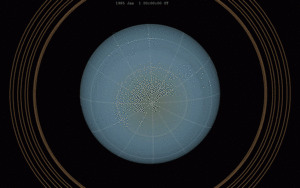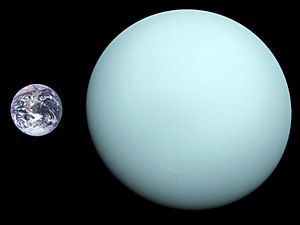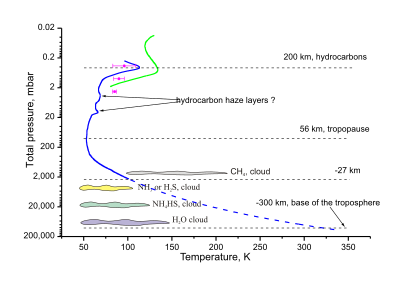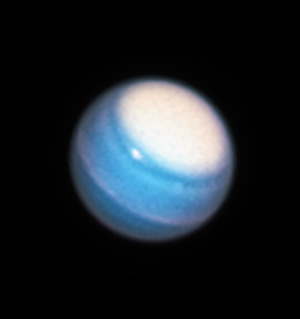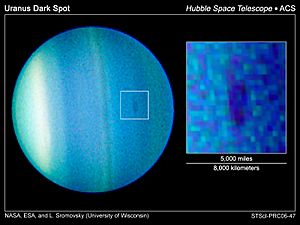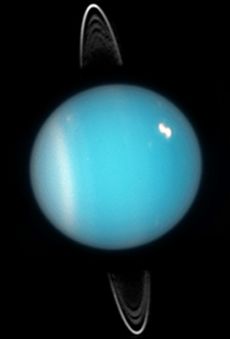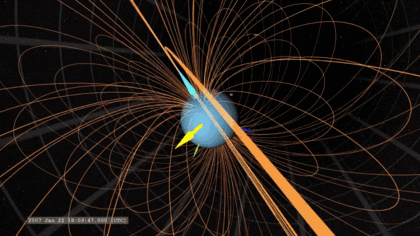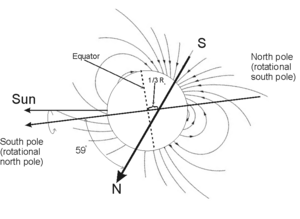Uranus facts for kids
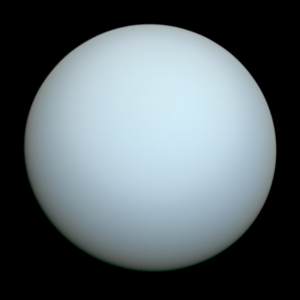
Uranus in true colour, as captured by Voyager 2. Its pale, muted appearance is due to a shroud of haze above its clouds
|
|||||||||||||
| Discovery | |||||||||||||
|---|---|---|---|---|---|---|---|---|---|---|---|---|---|
| Discovered by | William Herschel | ||||||||||||
| Discovery date | 13 March 1781 | ||||||||||||
| Designations | |||||||||||||
| Pronunciation | |||||||||||||
|
Named after
|
the Latin form Ūranus of the Greek god Οὐρανός Ouranos | ||||||||||||
| Adjectives | Uranian (/jʊˈreɪniən/) | ||||||||||||
| Orbital characteristics | |||||||||||||
| Epoch J2000 | |||||||||||||
| Aphelion | 20.0965 AU (3.00639 billion km) | ||||||||||||
| Perihelion | 18.2861 AU (2.73556 billion km) | ||||||||||||
| 19.19126 AU (2.870972 billion km) | |||||||||||||
| Eccentricity | 0.04717 | ||||||||||||
|
|||||||||||||
| 369.66 days | |||||||||||||
|
Average orbital speed
|
6.80 km/s | ||||||||||||
| 142.238600° | |||||||||||||
| Inclination |
|
||||||||||||
| 74.006° | |||||||||||||
| 17–19 August 2050 | |||||||||||||
| 96.998857° | |||||||||||||
| Known satellites | 28 | ||||||||||||
| Physical characteristics | |||||||||||||
|
Mean radius
|
25,362±7 km | ||||||||||||
|
Equatorial radius
|
25,559±4 km 4.007 Earths |
||||||||||||
|
Polar radius
|
24,973±20 km 3.929 Earths |
||||||||||||
| Flattening | 0.0229±0.0008 | ||||||||||||
| Circumference | 159,354.1 km | ||||||||||||
| 8.1156×109 km2 15.91 Earths |
|||||||||||||
| Volume | 6.833×1013 km3 63.086 Earths |
||||||||||||
| Mass | (8.6810±0.0013)×1025 kg 14.536 Earths GM=5,793,939±13 km3/s2 |
||||||||||||
|
Mean density
|
1.27 g/cm3 | ||||||||||||
| 8.69 m/s2 (0.886 g0) | |||||||||||||
|
Moment of inertia factor
|
0.23 (estimate) | ||||||||||||
| 21.3 km/s | |||||||||||||
| −0.718649 d −17h 14m 51s (retrograde) |
|||||||||||||
|
Sidereal rotation period
|
−0.718661 d −17h 14m 52.310s ± h 0.036s (retrograde) |
||||||||||||
|
Equatorial rotation velocity
|
2.59 km/s | ||||||||||||
| 82.23° (to orbit, retrograde). 97.77°(prograde, right-hand rule) | |||||||||||||
|
North pole right ascension
|
17h 9m 15s 257.311° |
||||||||||||
|
North pole declination
|
−15.175° | ||||||||||||
| Albedo | 0.300 (Bond) 0.488 (geom.) |
||||||||||||
|
|||||||||||||
| 5.38 to 6.03 | |||||||||||||
| −7.2 | |||||||||||||
| 3.3″ to 4.1″ | |||||||||||||
| Atmosphere | |||||||||||||
| 27.7 km | |||||||||||||
| Composition by volume | Below 1.3 bar (130 kPa):
|
||||||||||||
Uranus is the seventh planet from the Sun. It is a huge, cyan-colored ice giant planet. Most of Uranus is made of water, ammonia, and methane. These are in a special state called a "supercritical fluid," which scientists sometimes call "ice" or "volatiles."
The planet's atmosphere has many layers of clouds. It is the coldest planet in our Solar System, with temperatures as low as 49 K (−224 °C; −371 °F). Uranus spins on its side, with a very tilted axial tilt of 82.23 degrees. It also spins backwards, taking about 17 hours and 14 minutes to complete one rotation.
Because of its extreme tilt, one pole of Uranus faces the Sun for about 42 Earth years. This means it has continuous sunlight. Then, the other pole faces away for 42 years of continuous darkness. Uranus takes about 84 Earth years to orbit the Sun once.
Uranus is the third largest planet by diameter and the fourth largest by mass in our Solar System. Scientists believe it has a rocky core at its center. This core is surrounded by a thick layer of icy material, called a mantle. Around that is a thick atmosphere of hydrogen and helium.
Small amounts of other chemicals, like hydrocarbons and carbon monoxide, have been found in its upper atmosphere. These might come from comets. Uranus also has strange weather patterns, like very fast winds up to 900 km/h (560 mph). Its polar cap changes, and clouds form in unusual ways. Scientists are still trying to understand why Uranus has so little internal heat compared to other giant planets.
Like other giant planets, Uranus has a ring system, a magnetosphere, and many natural satellites (moons). Its rings are very dark and reflect only a tiny amount of light. Uranus has 28 known moons. These include 18 regular moons, with 13 being small inner moons. The five largest moons are Miranda, Ariel, Umbriel, Titania, and Oberon. There are also ten irregular moons that orbit much farther away.
Uranus's magnetosphere is very unusual and uneven. It has many charged particles. These particles might be causing the rings and moons to look dark.
You can see Uranus without a telescope, but it looks very dim. It was not known as a planet until 1781. That's when William Herschel first observed it. About 70 years later, it was named after the Greek god Uranus.
As of 2025, only one spacecraft has visited Uranus. This was the Voyager 2 probe, which flew past it in 1986. Scientists really want to send another mission to Uranus. The proposed Uranus Orbiter and Probe mission is a top priority for future space exploration. China's space agency, CNSA, also plans to send a subprobe from its Tianwen-4 mission to fly by Uranus in 2045.
Contents
How Uranus Was Discovered
Even though Uranus can be seen without a telescope, ancient observers never recognized it as a planet. This is because it is very dim and moves slowly across the sky.
On March 13, 1781, William Herschel observed Uranus. This led to its discovery as a planet. It was the first planet found with a telescope. This discovery also doubled the known size of our Solar System. Uranus is about twice as far from the Sun as Saturn.
Early Sightings of Uranus

Before it was known as a planet, Uranus was seen many times. But it was always mistaken for a star. The earliest possible sighting might have been by Hipparchus in 128 BC. He may have listed it in his star catalogue.
The first definite sighting was in 1690. John Flamsteed observed it at least six times. He listed it as a star called 34 Tauri. Later, French astronomer Pierre Charles Le Monnier saw Uranus at least twelve times between 1750 and 1769.
William Herschel first saw Uranus on March 13, 1781. He was in his garden in Bath, England. He first thought it was a comet. He used a homemade telescope to observe it.
Herschel wrote in his journal that it was "either [a] Nebulous star or perhaps a comet." A few days later, he realized it had moved. When he told the Royal Society about his discovery, he still called it a comet. But he also compared it to a planet. He noticed that unlike stars, its size seemed to grow when he used higher magnification.
Other astronomers soon suspected it was not a comet. Anders Johan Lexell in Russia calculated its orbit. Its path was nearly circular, like a planet's, not stretched out like a comet's. Johann Elert Bode in Berlin also said it was "a moving star that can be deemed a hitherto unknown planet-like object."
Soon, everyone agreed it was a new planet. By 1783, Herschel himself accepted this. King George III gave Herschel money each year for his discovery.
How Uranus Got Its Name
The name Uranus comes from the ancient Greek god of the sky, Ouranos. In Roman myths, he was called Caelus. He was the father of Cronus (who the Romans called Saturn). This makes Uranus the only planet named after a Greek god, not a Roman one.
The most common way astronomers say Uranus is /ˈjʊərənəs/ (YOOR-ə-nəs). This pronunciation helps avoid confusion with other words.
It took almost 70 years for everyone to agree on the name. Herschel wanted to name it Georgium Sidus (George's Star) after King George III. He thought it would be a good way to remember when the planet was found.
But this name was not popular outside of Britain. Other astronomers suggested names like Herschel (after its discoverer) or Neptune. The name Neptune was later used for the next planet discovered.

In 1782, Johann Elert Bode suggested Uranus. He argued that the new planet's name should fit with the names of the other planets, which came from Roman gods. He also liked that Uranus was the father of Saturn, just as Saturn was the father of Jupiter. In 1789, a chemist named his new element uranium to support Bode's choice. By 1850, the name Uranus was used everywhere.
Uranus has two main symbols. The first, ![]() , was suggested by Johann Gottfried Köhler. It looks like the symbol for platinum. The second symbol,
, was suggested by Johann Gottfried Köhler. It looks like the symbol for platinum. The second symbol, ![]() , was suggested by Lalande. It looks like a globe with the letter 'H' for Herschel on top. This second symbol is often used in astrology.
, was suggested by Lalande. It looks like a globe with the letter 'H' for Herschel on top. This second symbol is often used in astrology.
In other languages, Uranus has different names. In Chinese, Japanese, Korean, and Vietnamese, it means "Heavenly King star." In Thai, it can mean "Star of Death." In Hawaiian, it is called Heleʻekala, which is the Hawaiian way of saying 'Herschel'.
How Uranus Formed
Scientists believe that the differences between ice giants (like Uranus and Neptune) and gas giants (like Jupiter and Saturn) come from how they formed. Our Solar System likely formed from a spinning disk of gas and dust. Most of this gas formed the Sun. The dust grains clumped together to make early planets.
As these planets grew, some gathered enough gas for their gravity to hold onto it. The more gas they held, the bigger they got. This continued until they reached a point where their size grew very quickly. Ice giants, like Uranus, only gathered a few Earth masses of this gas. They never reached that fast-growth point.
Recent computer models suggest that both Uranus and Neptune formed closer to the Sun. Then, they slowly moved outwards to their current positions. This idea is part of the Nice model.
Uranus's Orbit and Spin
Uranus takes about 84 Earth years to go around the Sun once. Since its discovery in 1781, it has returned to the same spot in the sky twice: in 1865 and 1949. It will be there again in April 2033.
Its average distance from the Sun is about 20 AU (3 billion km; 2 billion mi). This is about 20 times farther than Earth is from the Sun. So, the sunlight on Uranus is about 400 times weaker than on Earth.
Scientists first calculated Uranus's orbit in 1783. Over time, its actual path in space didn't quite match the predictions. In 1841, John Couch Adams suggested that an unseen planet might be pulling on Uranus. In 1845, Urbain Le Verrier also studied this. On September 23, 1846, Johann Gottfried Galle found a new planet, later named Neptune, almost exactly where Le Verrier predicted.
The inside of Uranus spins once every 17 hours, 14 minutes, and 52 seconds. We know this by tracking its aurorae. Like all giant planets, its upper atmosphere has strong winds that blow in the direction of its spin. At some latitudes, like 60 degrees south, visible parts of the atmosphere move much faster, completing a full rotation in as little as 14 hours.
Uranus's Tilted Spin
Uranus's spin axis is almost parallel to the plane of the Solar System. Its axial tilt is about 97.77 degrees. This means it spins almost completely on its side. This tilt gives Uranus very different seasons compared to other planets.
Near the solstice (summer or winter), one pole faces the Sun all the time. The other pole faces away, always in darkness. Only a small area around the equator has a quick day-night cycle. Each pole gets about 42 years of continuous sunlight, followed by 42 years of darkness. Near the equinoxes (spring or autumn), the Sun shines on Uranus's equator. This creates day-night cycles similar to Earth's.
Even though the poles get more sunlight over a Uranian year, the equator of Uranus is hotter than its poles. Scientists don't know why this happens. The reason for Uranus's unusual tilt is also a mystery. One idea is that a large object, perhaps Earth-sized, crashed into Uranus billions of years ago. This collision could have knocked the planet onto its side.
| Northern hemisphere | Year | Southern hemisphere |
|---|---|---|
| Winter solstice | 1902, 1986, 2069 | Summer solstice |
| Vernal equinox | 1923, 2007, 2092 | Autumnal equinox |
| Summer solstice | 1944, 2028 | Winter solstice |
| Autumnal equinox | 1965, 2050 | Vernal equinox |
Seeing Uranus from Earth
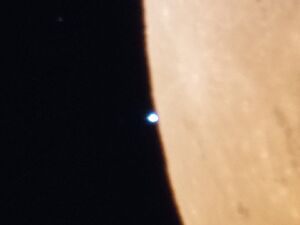
Uranus is usually too dim to see easily with the naked eye. But in very dark skies, you might spot it. With binoculars, it's an easy target even in cities. Through a medium-sized telescope, Uranus looks like a pale blue-green disk. You can see its edges are darker. With a larger telescope, you might even see some cloud patterns and its biggest moons, Titania and Oberon.
What Uranus is Made Of
Uranus is about 14.5 times more massive than Earth. This makes it the least massive of the giant planets. Its diameter is about four times that of Earth, slightly larger than Neptune. Uranus is the second least dense planet, after Saturn. This tells us it's mostly made of different kinds of ices, like water, ammonia, and methane.
Scientists believe Uranus has three main layers. At the center is a rocky core, made of silicates and iron-nickel. Around that is a thick, icy mantle. The outermost layer is a gaseous envelope of hydrogen and helium.
The core is quite small, about 0.55 times the mass of Earth. The mantle makes up most of the planet, about 13.4 Earth masses. The outer atmosphere is much lighter, about 0.5 Earth masses. The core is very dense, with extreme pressure and temperatures up to 5000 K.
The icy mantle isn't ice in the normal sense. It's a hot, dense fluid of water, ammonia, and other chemicals. This fluid can conduct electricity and is sometimes called a water-ammonia ocean.
The extreme pressure inside Uranus might break apart methane molecules. This could cause carbon atoms to form diamond crystals. These diamonds might then rain down through the mantle like hail. This idea is also thought to happen on Jupiter, Saturn, and Neptune. Some scientists even suggest there might be an ocean of liquid carbon, with solid "diamond-bergs" floating in it, deep inside Uranus.
Uranus and Neptune are called ice giants because they have more ice than gas, unlike Jupiter and Saturn. There might also be a layer of "ionic water" where water molecules break into hydrogen and oxygen ions. Deeper down, there could be "superionic water" where oxygen forms a crystal structure, but hydrogen ions move freely.
Scientists use models to understand Uranus's structure. These models fit what we observe. For example, if there's a lot of hydrogen and rock mixed in the ice mantle, the total mass of ice would be lower. We don't have enough data yet to know which model is exactly right.
Uranus doesn't have a solid surface like Earth. Its gaseous atmosphere gradually turns into its liquid layers. For convenience, scientists define a "surface" where the atmospheric pressure is 1 bar. This is the reference point for altitudes.
Uranus's Internal Heat
Uranus produces much less internal heat than the other giant planets. Scientists don't fully understand why. Neptune, which is similar in size and makeup, gives off 2.61 times more energy than it gets from the Sun. But Uranus hardly gives off any extra heat.
The lowest temperature recorded in Uranus's atmosphere is 49 K (−224.2 °C; −371.5 °F), making it the coldest planet in the Solar System.
One idea is that the giant impact that tilted Uranus also caused it to lose most of its original heat. Another idea is that something in Uranus's upper layers stops heat from the core from reaching the surface. For example, different layers might prevent heat from moving upwards easily.
A 2021 study suggested that large amounts of magnesium could dissolve in the liquid interiors of Uranus and Neptune. If Uranus has more magnesium than Neptune, it could create a layer that traps heat, explaining its low temperature.
Uranus's Atmosphere
Uranus's atmosphere is the outermost part of its gas envelope that we can study. It extends far out into space. The atmosphere can be divided into three layers: the troposphere, the stratosphere, and the thermosphere.
What the Atmosphere is Made Of
Uranus's atmosphere is mostly molecular hydrogen and helium. It also has a lot of methane, which gives Uranus its blue-green color. Methane makes up about 2.3% of the atmosphere below the clouds. This is much more carbon than found in the Sun.
Higher up, the amount of methane is lower because it's so cold that methane freezes out. Scientists don't know much about other chemicals like ammonia, water, and hydrogen sulfide deep in the atmosphere. Small amounts of other hydrocarbons, like ethane and acetylene, are found in the stratosphere. These are made when sunlight breaks down methane. Traces of water vapor, carbon monoxide, and carbon dioxide have also been found. These likely come from outside sources, like dust and comets.
Layers of the Atmosphere
The troposphere is the lowest and densest part of the atmosphere. Here, the temperature gets colder as you go higher. It drops from about 320 K (47 °C; 116 °F) at the bottom to 53 K (−220 °C; −364 °F) at 50 km up. The coldest part of the troposphere is called the tropopause, where temperatures range from 49 and 57 K (−224 and −216 °C; −371 and −357 °F).
The troposphere likely has many complex cloud layers. Water clouds might be very deep, followed by ammonium hydrosulfide clouds, then ammonia or hydrogen sulfide clouds. Thin methane clouds are found higher up. The troposphere is a very active part of the atmosphere, with strong winds and changing clouds.
The middle layer is the stratosphere. Here, the temperature generally increases with height. This heating happens because methane and other hydrocarbons absorb sunlight. These hydrocarbons form from methane being broken down by ultraviolet light. They are found in a narrow layer between 100 and 300 km up.
The most common hydrocarbons are methane, acetylene, and ethane. Heavier hydrocarbons and carbon dioxide are also present in smaller amounts. Ethane and acetylene can condense in the colder lower stratosphere, forming haze layers. These hazes might be why Uranus looks so plain.

The outermost layer is the thermosphere. It has a very high, uniform temperature of about 800 K (527 °C) to 850 K (577 °C). Scientists don't fully understand what causes these high temperatures. The thermosphere also contains many free hydrogen atoms. Because they are so light and hot, the outer part of the atmosphere, called the corona, extends very far out, up to 50,000 km from the surface.
This extended corona is unique to Uranus. It creates a drag on small particles orbiting Uranus, which helps clear dust from its rings. The thermosphere and upper stratosphere form Uranus's ionosphere. This layer is denser than on Saturn or Neptune. It is mainly kept going by solar ultraviolet radiation.
Uranus's Climate and Weather
Uranus's atmosphere looks very plain compared to other giant planets, even Neptune. When Voyager 2 flew by in 1986, it saw only 10 cloud features on the whole planet. One reason for this lack of features is that Uranus has very little internal heat. It is the coldest planet in the Solar System.
Winds and Clouds on Uranus
In 1986, Voyager 2 found that Uranus's southern hemisphere had two main areas: a bright polar cap and dark bands around the equator. A bright band called a "southern collar" was seen near 45 degrees south latitude. Scientists think the cap and collar are dense methane clouds. Voyager 2 also saw ten small bright clouds. In 1986, Uranus seemed like a very calm planet.
Voyager 2 arrived during Uranus's southern summer, so it couldn't see the northern hemisphere. In the early 2000s, when the northern pole became visible, the Hubble Space Telescope (HST) and Keck telescope didn't see a collar or polar cap there. So, Uranus seemed uneven. But in 2007, when Uranus reached its equinox, the southern collar almost disappeared, and a faint northern collar appeared. In 2023, a team using the Very Large Array saw a dark collar and a bright spot at the north pole, suggesting a polar vortex.
In the 1990s, many more bright clouds were seen, especially in the northern hemisphere. These northern clouds are smaller, sharper, and brighter. They seem to be higher up. Some small clouds last only a few hours, but one southern cloud might have been there since the Voyager 2 flyby. Scientists also found that Uranus's clouds are similar to Neptune's. For example, dark spots, common on Neptune, were seen on Uranus for the first time in 2006. This suggests Uranus is becoming more like Neptune during its equinox season.
By tracking these clouds, scientists measured the winds in Uranus's upper troposphere. At the equator, winds blow backwards, opposite to the planet's spin. Their speeds are from −360 to −180 km/h (−220 to −110 mph). Closer to the poles, the winds switch direction and blow with Uranus's spin. They reach speeds of up to 860 km/h (540 mph) near 50 degrees latitude in the northern hemisphere.
In 1986, Voyager 2 detected 140 lightning flashes on Uranus. These flashes were very powerful, much stronger than lightning on Earth. They lasted about 120 milliseconds. Scientists think this lightning happens in deep water clouds in the troposphere.
Seasonal Changes on Uranus
For a short time in 2004, large clouds appeared in Uranus's atmosphere, making it look more like Neptune. Record-breaking wind speeds of 820 km/h (510 mph) were seen, along with a long-lasting thunderstorm. Scientists don't fully know why this sudden activity happened. It seems that Uranus's extreme tilt causes extreme seasonal changes in its weather.
It's hard to study these seasonal changes because we've only had good data on Uranus's atmosphere for less than one full Uranian year (84 Earth years). But measurements over the past half-century show that Uranus's brightness changes regularly. It is brightest during the solstices and dimmest during the equinoxes.
There are signs that real physical changes are happening on Uranus. The bright south polar region and the dim north pole don't fit the simple seasonal model. In 1944, during its previous northern solstice, Uranus was brighter. This suggests the north pole brightens before the solstice and darkens after the equinox.
In the 1990s, as Uranus moved away from its solstice, the south polar cap darkened. But the northern hemisphere became more active, with more clouds and stronger winds. This supported the idea that it would brighten soon. This happened in 2007 when it passed an equinox. A faint northern polar collar appeared, and the southern collar almost vanished.
The reason for these changes is still unclear. Near the solstices, Uranus's hemispheres are either fully lit by the Sun or facing deep space. The brightening of the sunlit hemisphere might be due to thicker methane clouds and haze layers. The bright collar at -45 degrees latitude is also linked to methane clouds. Other changes in the southern polar region could be due to changes in lower cloud layers.
Uranus's Magnetic Field
Before Voyager 2 arrived in 1986, no one had measured Uranus's magnetosphere. Scientists expected its magnetic field to line up with the solar wind and Uranus's poles.
But Voyager 2's observations showed that Uranus's magnetic field is very strange. It doesn't come from the planet's exact center. It's also tilted by 59 degrees from the planet's spin axis. The magnetic center is shifted towards the south pole by about one-third of Uranus's radius.
This unusual setup makes the magnetosphere very uneven. The magnetic field strength on the surface can be as low as 0.1 gauss in the southern hemisphere and as high as 1.1 gauss in the northern hemisphere. Earth's magnetic field is much more even. Uranus's magnetic field is 50 times stronger than Earth's. Neptune also has a tilted and shifted magnetic field, suggesting this might be common for ice giants.
One idea is that the magnetic fields of ice giants are made by movement in shallower layers, like the water-ammonia ocean, not deep in the core like on Earth or gas giants. Another idea is that oceans of liquid diamond inside Uranus could affect the magnetic field.
Recent studies of Voyager 2 data from 2017 suggest that this unevenness causes Uranus's magnetosphere to connect with the solar wind once every Uranian day. This opens the planet to particles from the Sun. However, a 2024 study suggests that the very uneven shape seen by Voyager 2 might have been unusual. It could have been caused by unusually high solar wind density at that time.
Despite its strange alignment, Uranus's magnetosphere is similar to other planets in some ways. It has a bow shock (where the solar wind hits the magnetosphere), a magnetopause (the boundary of the magnetosphere), a magnetotail (a long tail of magnetic field lines), and radiation belts. Uranus's magnetotail stretches for millions of kilometers into space. It is twisted into a corkscrew shape by the planet's sideways spin.
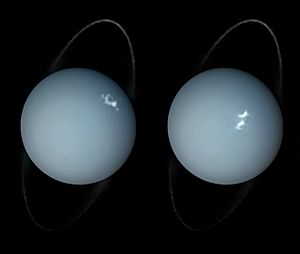
Uranus's magnetosphere contains charged particles, mostly protons and electrons. Many of these particles likely come from the thermosphere. The moons of Uranus also affect these particles. They sweep through the magnetosphere, creating gaps. These particles might be why Uranus's moons and rings are so dark.
Uranus has aurorae, which are bright arcs around its magnetic poles. Unlike Jupiter's, Uranus's aurorae don't seem to affect the planet's overall heat balance much.
In March 2020, NASA scientists reported finding a large atmospheric magnetic bubble, called a plasmoid, leaving Uranus. They found this by re-examining old data from the Voyager 2 probe.
Moons of Uranus

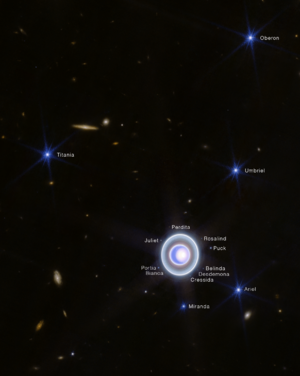
Uranus has 28 known natural satellites (moons). Their names come from characters in plays by William Shakespeare and poems by Alexander Pope. The five main moons are Miranda, Ariel, Umbriel, Titania, and Oberon.
The moons of Uranus are the least massive of all the giant planets' moon systems. All five major moons together would be less than half the mass of Neptune's largest moon, Triton. Titania, the largest moon of Uranus, has a radius of only 788.9 km (490.2 mi). This is less than half the size of Earth's Moon.
Uranus's moons are relatively dark. They are made of about 50% ice and 50% rock. The ice might include ammonia and carbon dioxide.
Among the moons, Ariel seems to have the youngest surface, with the fewest impact craters. Umbriel has the oldest surface. Miranda has deep canyons, layered areas, and a mix of surface ages. Miranda's past activity might have been caused by tidal heating when its orbit was more stretched out.
Uranus also has at least one "horseshoe orbiter" called 83982 Crantor. This object shares Uranus's orbit in a complex way.
Rings of Uranus
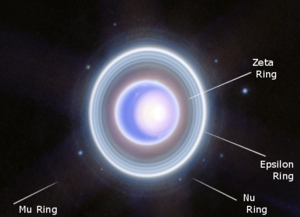
Uranus's rings are made of very dark particles. These particles range in size from tiny dust grains to pieces a fraction of a meter wide. There are 13 known rings. The brightest one is called the ε (epsilon) ring. Most of the rings are very narrow, only a few kilometers wide.
The rings are probably quite young. They likely didn't form at the same time as Uranus. The material in the rings might have once been part of a moon (or moons) that broke apart from high-speed impacts. Only a few pieces of this debris survived in stable areas, forming the rings we see today.
William Herschel described a possible ring around Uranus in 1789. But this sighting is usually doubted because the rings are very faint. For the next two centuries, no one else saw them.
The ring system was definitely discovered on March 10, 1977. Scientists were using an airplane observatory to study Uranus's atmosphere. They noticed that a star briefly disappeared five times before and after it went behind Uranus. They realized there must be a ring system around Uranus. Later, they found four more rings.
The rings were directly photographed when Voyager 2 flew past Uranus in 1986. Voyager 2 also found two more faint rings, bringing the total to eleven at that time.
In December 2005, the Hubble Space Telescope found two new rings. The largest of these is twice as far from Uranus as the previously known rings. These are called the "outer" ring system. Hubble also spotted two small moons. One of them, Mab, shares its orbit with the outermost new ring. These new rings brought the total number of Uranian rings to 13.
In April 2006, images from the Keck Observatory showed the colors of the outer rings. The outermost ring is blue, and the other new one is red. One idea for the blue color is that it's made of tiny water ice particles from Mab's surface. These particles are small enough to scatter blue light. In contrast, Uranus's inner rings look gray.
Even though Uranus's rings are hard to see from Earth, new digital cameras allow amateur astronomers to photograph them. Telescopes as small as 36 cm (14 inches) can detect the rings with the right equipment.
Exploring Uranus
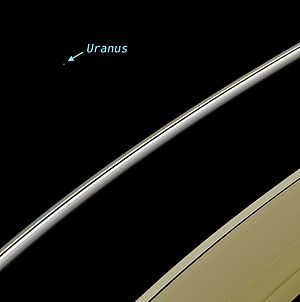
The Voyager 2 spacecraft was launched in 1977. It made its closest approach to Uranus on January 24, 1986. It came within 81,500 km (50,600 mi) of the cloud tops. Then, it continued its journey to Neptune.
Voyager 2 studied Uranus's atmosphere, including its unique weather caused by its extreme tilt. It also made the first detailed studies of its five largest moons and discovered 10 new ones. Voyager 2 looked at all nine of the known rings and found two more. It also studied Uranus's magnetic field, which has a strange structure and a unique corkscrew-shaped magnetotail.
No other spacecraft has flown by Uranus since then. But many missions have been suggested to revisit the Uranus system. For example, the Uranus Orbiter and Probe mission was recommended as a top priority in 2011 and again in 2022. This mission would launch around 2020-2023 and take about 13 years to reach Uranus.
Most recently, China's CNSA plans for its Tianwen-4 Jupiter orbiter, launching in 2029, to have a subprobe. This subprobe will detach and fly by Uranus in March 2045 before heading into interstellar space. China also has plans for a possible Tianwen-5 mission that might orbit either Uranus or Neptune.
Uranus in Culture
Uranus has been a popular topic in stories and art. It inspired Lydia Sigourney's 1827 poem "The Georgian Planet." It also inspired a part of Gustav Holst's orchestral music suite The Planets, written between 1914 and 1916. The discovery of Uranus is mentioned in John Keats's poem "On First Looking into Chapman's Homer". The planet's discovery also led to the naming of the chemical element uranium in 1789.
In modern astrology, Uranus is the ruling planet of the zodiac sign Aquarius. Before Uranus was discovered, Saturn was considered Aquarius's ruling planet. Because Uranus is blue-green, the color electric blue is linked to the sign Aquarius.
Interesting facts about Uranus
- Uranus is the only planet named after a Greek god, while the others are named after Roman gods.
- The planet is visible to the naked eye.
- It doesn't have a solid surface like Earth.
- Winds in its atmosphere can be very strong, blowing at hundreds of kilometers per hour.
- As of 2023, it was visited up close only once when in 1986 the Voyager 2 probe flew by the planet.
- Its average distance from the Sun is about 20 times the distance between the Earth and the Sun. This means sunlight is much, much weaker at Uranus than it is here.
- Scientists aren't completely sure why Uranus is tilted so much, but the most popular idea is that a very large object, perhaps about the size of Earth, crashed into it billions of years ago and knocked it onto its side.
- Uranus's magnetosphere traps charged particles, forming radiation belts. These particles can interact with the planet's atmosphere to create aurorae, similar to the Northern and Southern Lights on Earth.
- The chemical element uranium, discovered in 1789 by the German chemist Martin Heinrich Klaproth, was named after the then-newly discovered Uranus.
- Operation Uranus was the successful military operation in World War II by the Red Army to take back Stalingrad and marked the turning point in the land war against the Wehrmacht.
- In astrology, the planet Uranus (symbol
 ) is the ruling planet of Aquarius.
) is the ruling planet of Aquarius. - Because Uranus is cyan and Uranus is associated with electricity, the colour electric blue, which is close to cyan, is associated with the sign Aquarius.
See also
 In Spanish: Urano (planeta) para niños
In Spanish: Urano (planeta) para niños
- Colonizing Uranus
- Extraterrestrial diamonds (thought to be common in Uranus)
- Outline of Uranus
- Facts about planets in the Solar System
- Uranus in astrology
- Uranus in fiction



